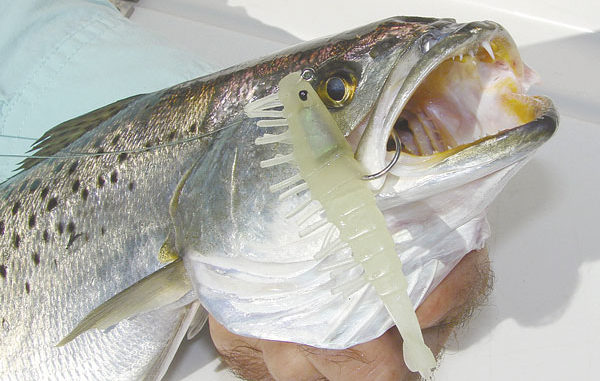
Waters around Harkers Island offer great January action on speckled trout.
While it bustles along pretty well from about Easter to Thanksgiving, Harkers Island is a very slow-paced place during the winter — and that’s not a bad thing. About the only people around are the locals and a few hardy fishermen who know the speckled trout season doesn’t end with the first time the water freezes in the dog’s bowl. For those folks willing to wear snuggies, a heavy coat and gloves, there are trout to be caught all winter.
Capt. Noah Lynk is a Carteret County native who works for the N.C. Ferry Service and spends most of his off-days chasing fish on the waters around Harkers Island — from Cape Lookout to the Newport River “haystacks” and up Core Sound to Jarrett Bay and across to Drum Inlet on the Core Banks side. The odds are pretty good he knows about it if any fish are biting.
On one chilly morning, Lynk suggested sleeping in a while to give the sun a little time to warm things up and allow the falling tide to bottom out. Leaving from We would depart from Cape Pointe Marina (formerly Barbour’s Marina) at 9:30, Lynk’s advice was to dress warmly and in layers. Even though there had been a week of warm, sunny weather, the temperature still drops at night, and it takes a while to get warmed up.
Lynk was correct about the weather; a ski mask was in order for the ride around Harkers Island in his Bay Rider skiff. His first stop was along the causeway leading to the Harkers Island Bridge.
“See that fellow fishing from the pier?” Lynk asked as the anchor set and the boat swung around. “There is a little channel that starts about 20 feet over from us and runs almost to the pier. We should be anchored far enough away to prevent lines getting tangled. Use this rod with the shrimp bait on it and cast it up above the pier and let this incoming tide bounce it back to the fish. They’ll be biting light, maybe just a little tick, so be ready.”
Lynk had been catching some fish at the spot for a few days, and they were still around. On his second cast, a small speck decided it wanted the plastic shrimp. It really didn’t want it once it realized it wasn’t real, but the hook had found its mark, and it had to make the trip to the boat. It was a small trout, maybe legal, but not what Lynk was looking for, so it was quickly unhooked and released.
As the sun rose and the temperature continued to rise, another fisherman joined the one on the pier, and a pair walked down the side of the causeway. While everyone caught a speck or two, all were basically the same size as the “spike” specks Lynk had caught, and he decided it was time to try another place.
In the North River marshes, Lynk was surprised to find someone anchored beside the oyster rock he had planned to target. Waving, he eased by the fisherman to another spot a little farther off the Thoroughfare.
“I caught some here and over there a few days ago,” Lynk said. “This was my second choice coming in here, and it’s close enough we can see if that fellow catches anything, but not be close enough to bother him.”
After catching several more specks of the “maybe short/maybe barely” type — plus a black drum and a bluefish, Lynk was moving again.
Heading up North River to the US 70 bridge, Lynk said he was really glad to see all the small trout, as they were a good sign for the future. Some people don’t have anything good to say about them, but unless there is a hard freeze this winter, they should be nice keeper trout by next fall.
It was obvious that area fishermen had heard trout were biting at the bridge. Two boats were anchored, and two fishermen were casting from the bank. In the time it took to creep in and quietly set the anchor at a respectable distance, two specks were landed on one of the other boats.
On his first cast, Lynk connected with another spike trout. Strikes continued to come regularly, but most were small fish. After a few minutes the folks in the closest boat dropped one in their cooler instead of back overboard. A few minutes later, one of the fishermen on the bank landed a nice fish. He was too far away to understand his words, but the excitement in his voice was obvious.
Unfortunately that little flurry only lasted a few minutes. While the spikes were still biting strong, no more of the larger fish were caught.
After a while Lynk said, “Well fellows, this is fun, but we need to find some larger fish. The tide has risen enough we should be able to get to where I’ve been seeing a little bait and catching some larger fish. I was hoping with this warm, sunny weather, they had moved out to open water, but it appears only the small ones have moved.”
Running back to the river, Lynk zig-zagged around and between some barely covered oyster bars and crept back into a little creek. He carefully eased over an anchor with no chain to avoid it rattling and spooking the fish.
“There is an oyster bar over there running down the creek,” Lynk said pointing to the ripple on top of the bar. “Cast over there and let the incoming tide bounce your shrimp down the bar like it was tired and cold and would be easy prey. They might let it pass a few times before they decide to eat, but they should feed in this warm sunlight.”
It took a little while, but suddenly, a “There he is!” rang out, and a rod was bent and pulsing. Sure enough, this trout had the energy to run side-to-side a little and was definitely shaking its head. When it saw the boat, it got a second wind and peeled some more line off the little Shimano spinning reel. Finally, it came to the boat, and Lynk called for the net.
The trout began biting in that little creek, and the action continued for more than an hour. It wasn’t an every-cast bite like it often is during the fall, but it wasn’t bad for a winter day that began barely 10 degrees above freezing. The trout weren’t huge, but the big guys averaged about two to three pounds and were nice and healthy. It was obvious they had been eating well.
When this bite slowed, Lynk made a final move, to a mud flat he said usually warmed during the low end of the tide cycle, and then attracted fish as the tide covered it back. He anchored beside the bank and pointed out a long riffle running down the oyster bar that marked the outside of the little flat. He said he had caught trout, plus red and black drum and even a flounder in the previous week.
It wound up being a hot spot for more small specks and fish with colors in their names. A red drum, two black drum and a pair of bluefish were also added to the day’s catch-and-release tally.

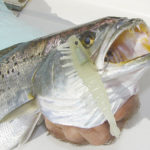
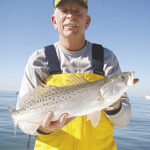
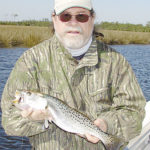
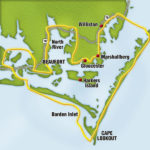
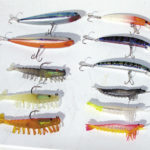



Be the first to comment